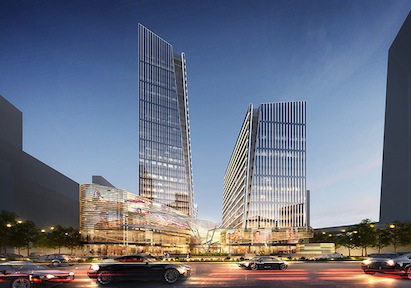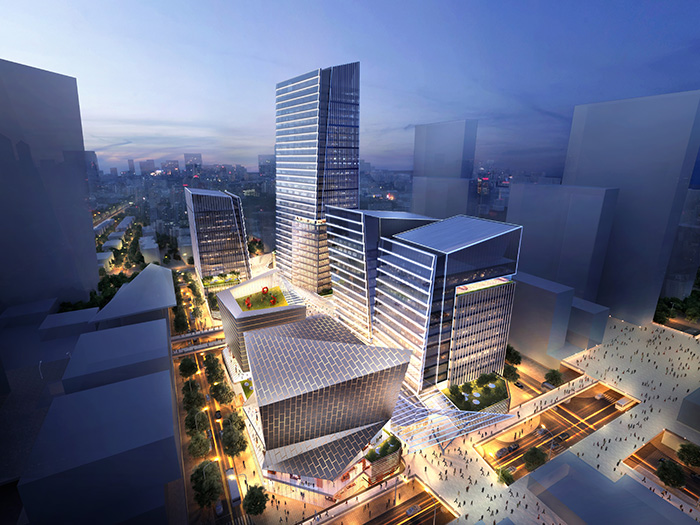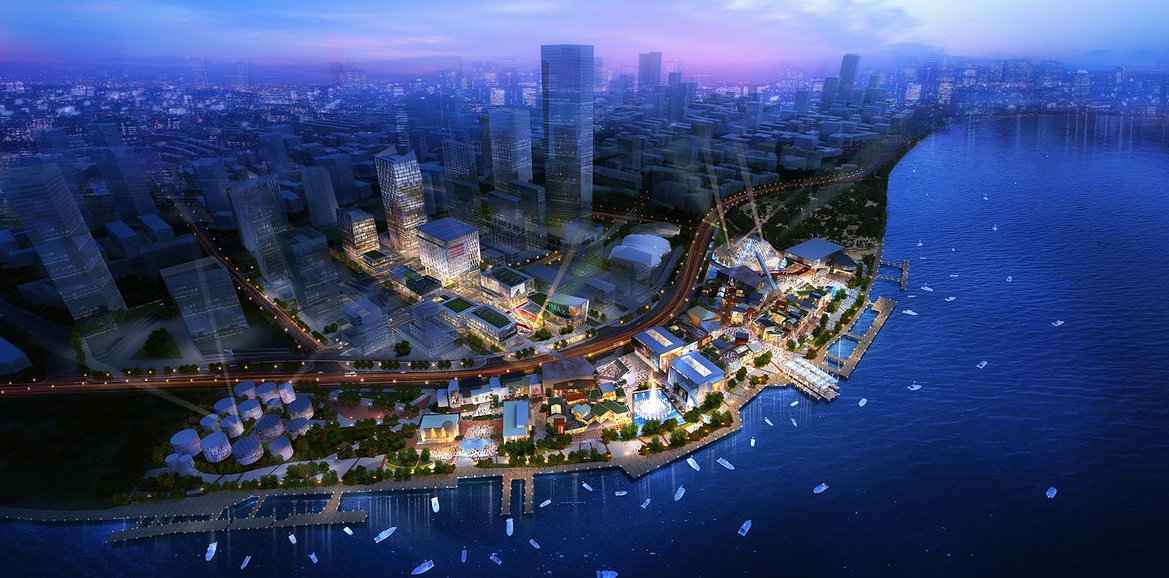International architecture firm Kohn Pedersen Fox Associates (KPF) is pleased to unveil designs for DreamWorks Asia Headquarters, Oriental Dreamworks and creative offices in the new Shanghai DreamCenter, which constitutes one of the most exciting projects in China.
Located along the riverside in Xuhui District, the 463,000-square-meter DreamCenter is an integrated cultural and lifestyle landmark that will feature performing arts spaces, creative media spaces, black box and imax theaters, as well as world-class entertainment, fashionable retail areas and premium restaurants and bars.
“Together with the West Bund Media Port, this will become the world’s third great urban center for entertainment and arts alongside New York’s Broadway and London’s West End,” said DreamWorks Animation CEO Jeffrey Katzenberg. With offices on New York’s 42nd Street and in London’s Covent Garden, KPF is quite literally ‘in’ show business and has come to know what makes such creative capitals tick. In the words of KPF Principal Paul Katz, “We also know first-hand the value of locating in such creative cores, for our process, our staff, and our work as architects.”
A collaboration between Hong Kong Lan Kwai Fong Group, DreamWorks Animation and Shanghai China Media Capital, the DreamCenter is the flagship project of Shanghai’s West Bund Media Port, a large-scale development focused on creative and digital media, technology, and cultural industries.
Katz commented, “We’ve watched Shanghai develop into a global city. And now, three visionaries, three of the most influential shapers of global culture in the 21st century are coming together to create its creative hub: Jeffrey Katzenberg, who heads one of the most influential studios in the industry; Allan Zeman, who has made such a huge contribution to Hong Kong, including the development of Lan Kwai Fong in HK and now China, which transformed the culture of public space and demonstrated a new respect for international lifestyle and world-class entertainment; and Li Ruigang, the visionary who has punctuated the evolution of China’s media and entertainment industry. In 20 years, Shanghai has transformed itself from an agrarian-based economy to one of the leading post-industrial economies in Asia. The DreamCenter project will further define Shanghai’s role as a global meeting-place for creative industry, technology, entertainment, and culture.”
Through the revitalization of the hundred-year-old former cement factory and other industrial artifacts into iconic creative live performance venues and F&B facilities, DreamCenter blends together the site’s industrial and cultural history with modern architecture, offering an unseen experience for the people of Shanghai and international tourists.
KPF’s two-block design represents the creative heart of the master plan—and its largest district. The eastern block is home to a pair of creative office towers, a theater building and arts building, whose open-air rooftop features a sculpture garden. The western block features a pair of towers (DreamCenter’s tallest), which angle slightly as they rise above this space, framing the views westward towards the DreamCenter and Huangpu Riverfront and creating “sky canyons” that capture the sky by day and emanate light and activity by night. At the base of the tower, the design includes a direct connection to the Shanghai Metro, a shared retail podium, and an elevated pedestrian walkway lined with shops and restaurants that extends eastward to connect the entire development.
Like KPF’s designs for Roppongi Hills in Tokyo, Hudson Yards in New York, and Covent Garden in London, Shanghai DreamCenter will become the great gathering place for the city, bringing together diverse activities, industries, and cultures, and enabling this energy and streetlife to radiate outwards, activating the city.
Construction of the Shanghai DreamCenter will begin this year and is expected to complete in 2017.
About Kohn Pedersen Fox Associates (KPF)
Kohn Pedersen Fox Associates (KPF) is one of the world’s pre-eminent architecture firms, providing architecture, interior, programming and masterplanning services for clients in both the public and private sectors. Operating as one firm with six global offices, KPF is led by 24 Principals and 27 Directors. The firm’s 600+ staff members come from 43 different countries, speak more than 30 languages and include over 80 LEED accredited professionals.
KPF’s diverse portfolio, which features over 70 projects certified or pursuing green building certification, comprises corporate, hospitality, residential, academic, civic, transportation and mixed-use projects located in more than 35 countries. The firm’s recent work includes the Abu Dhabi International Airport, the Shanghai World Financial Center, the International Commerce Centre in Hong Kong, New Songdo City in Korea, the Mandarin Oriental Las Vegas, the RBC Centre and Ritz? Carlton in Toronto, and Heron Tower, Sixty London and Unilever House in London.
Related Stories
| Nov 16, 2010
Architecture Billings Index: inquiries for new projects remain extremely high
The new projects inquiry index was 61.7, down slightly from a nearly three-year high mark of 62.3 in September, according to the Architecture Billings Index (ABI). However, the ABI dropped nearly two points in October; the October ABI score was 48.7, down from a reading of 50.4 the previous month. The ABI reflects the approximate nine to 12 month lag time between architecture billings and construction spending.
| Nov 16, 2010
Brazil Olympics spurring green construction
Brazil's green building industry will expand in the coming years, spurred by construction of low-impact venues being built for the 2016 Olympics. The International Olympic Committee requires arenas built for the 2016 games in Rio de Janeiro meet international standards for low-carbon emissions and energy efficiency. This has boosted local interest in developing real estate with lower environmental impact than existing buildings. The timing couldn’t be better: the Brazilian government is just beginning its long-term infrastructure expansion program.
| Nov 16, 2010
Green building market grows 50% in two years; Green Outlook 2011 report
The U.S. green building market is up 50% from 2008 to 2010—from $42 billion to $55 billion-$71 billion, according to McGraw-Hill Construction's Green Outlook 2011: Green Trends Driving Growth report. Today, a third of all new nonresidential construction is green; in five years, nonresidential green building activity is expected to triple, representing $120 billion to $145 billion in new construction.
| Nov 16, 2010
Calculating office building performance? Yep, there’s an app for that
123 Zero build is a free tool for calculating the performance of a market-ready carbon-neutral office building design. The app estimates the discounted payback for constructing a zero emissions office building in any U.S. location, including the investment needed for photovoltaics to offset annual carbon emissions, payback calculations, estimated first costs for a highly energy efficient building, photovoltaic costs, discount rates, and user-specified fuel escalation rates.
| Nov 16, 2010
CityCenter’s new Harmon Hotel targeted for demolition
MGM Resorts officials want to demolish the unopened 27-story Harmon Hotel—one of the main components of its brand new $8.5 billion CityCenter development in Las Vegas. In 2008, inspectors found structural work on the Harmon didn’t match building plans submitted to the county, with construction issues focused on improperly placed steel reinforcing bar. In January 2009, MGM scrapped the building’s 200 condo units on the upper floors and stopped the tower at 27 stories, focusing on the Harmon having just 400 hotel rooms. With the Lord Norman Foster-designed building mired in litigation, construction has since been halted on the interior, and the blue-glass tower is essentially a 27-story empty shell.
| Nov 16, 2010
Where can your firm beat the recession? Try any of these 10 places
Wondering where condos and rental apartments will be needed? Where companies are looking to rent office space? Where people will need hotel rooms, retail stores, and restaurants? Newsweek compiled a list of the 10 American cities best situated for economic recovery. The cities fall into three basic groups: Texas, the New Silicon Valleys, and the Heartland Honeys. Welcome to the recovery.
| Nov 16, 2010
Landscape architecture challenges Andrés Duany’s Congress for New Urbanism
Andrés Duany, founder of the Congress for the New Urbanism, adopted the ideas, vision, and values of the early 20th Century landscape architects/planners John Nolen and Frederick Law Olmsted, Jr., to launch a movement that led to more than 300 new towns, regional plans, and community revitalization project commissions for his firm. However, now that there’s a societal buyer’s remorse about New Urbanism, Duany is coming up against a movement that sees landscape architecture—not architecture—as the design medium more capable of organizing the city and enhancing the urban experience.
| Nov 16, 2010
Just for fun: Words that architects use
If you regularly use such words as juxtaposition, folly, truncated, and articulation, you may be an architect. Architects tend to use words rarely uttered during normal conversations. In fact, 62% of all the words that come out of an architects mouth could be replaced by a simpler and more widely known word, according to this “report.” Review this list of designer words, and once you manage to work them into daily conversation, you’re on your way to becoming a bonafide architect.
| Nov 16, 2010
NFRC approves technical procedures for attachment product ratings
The NFRC Board of Directors has approved technical procedures for the development of U-factor, solar heat gain coefficient (SHGC), and visible transmittance (VT) ratings for co-planar interior and exterior attachment products. The new procedures, approved by unanimous voice vote last week at NFRC’s Fall Membership Meeting in San Francisco, will add co-planar attachments such as blinds and shades to the group’s existing portfolio of windows, doors, skylights, curtain walls, and window film.











